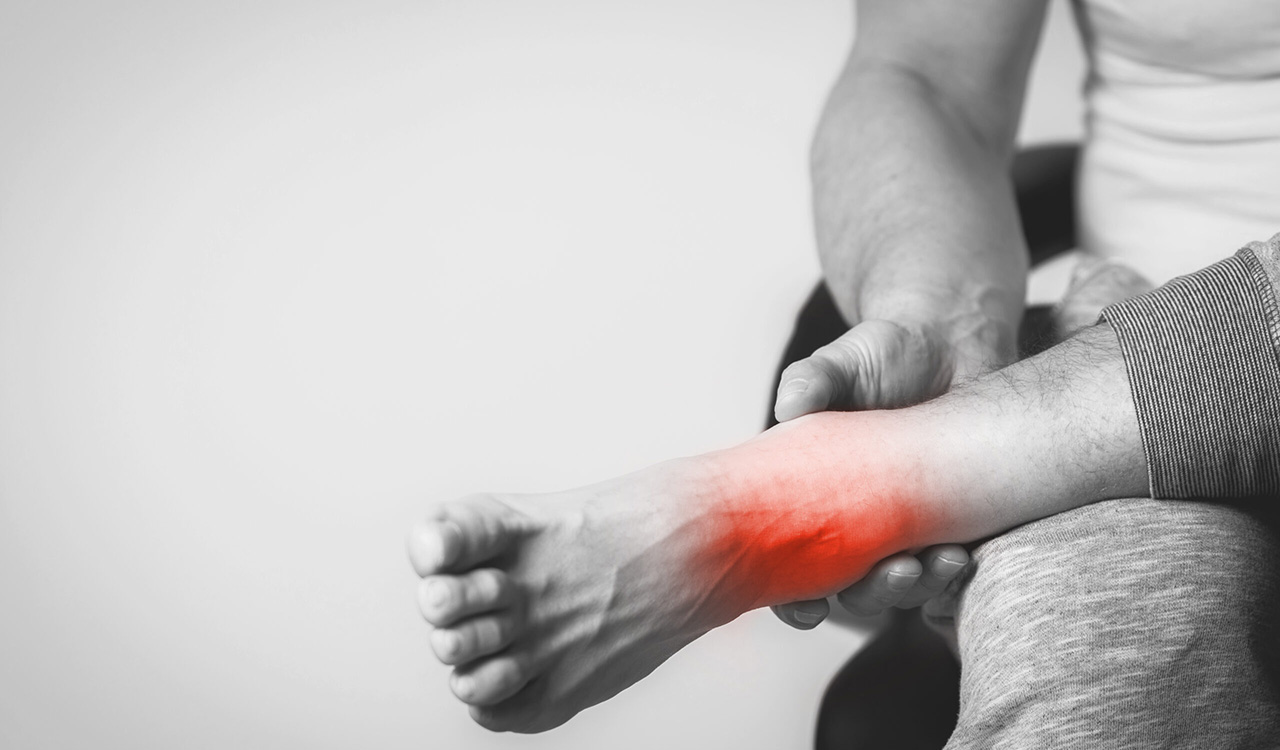
Small fiber neuropathy (SFN) is a type of peripheral neuropathy in which only the small sensory nerves are affected. It is often characterized by severe pain attacks, described as stabbing or burning, that usually begins in the hands or feet. Over time, sensory disturbances may progress to other regions of the body, including the trunk and sometimes even the face.
Symptoms of SFN may vary, depending on where the nerves are affected. In general, individuals with this condition cannot feel sensations that are concentrated in a very small area, such as pinpricks. Instead, they may have increased sensitivity to generalized pain or experience pain from stimuli that typically do not cause pain.
Others may experience autonomic dysfunctions including, but not limited to, urinary or bowel problems, heart rhythm or blood pressure fluctuations, and dry eyes or mouth.
Because of the variety of possible symptoms, SFN is often overlooked. Although the actual prevalence is not defined, approximately 40 million people in the United States are estimated to be affected. Diagnosis is dependent on the individual’s medical history, clinical examinations, and supporting laboratory investigations.
Can IVIG help? | Free IVIG Treatment Info | Difficulty In Diagnosing?
How Serious Is Small Fiber Neuropathy?
Small fiber neuropathy is sometimes described as an underlying health ailment in diabetes and many autoimmune and inherited diseases. When a patient has SFN, damage in small fibers produces burning pain and prickling or stinging-like sensations. These abnormal feelings usually start from the feet and spread up the legs to the entire body. At the start of the disease, patients feel general body pain, and some also complain about severe pain at night and during times of rest.
If you are feeling these signs and symptoms, promptly seek help from your physician. Make sure you get a physical examination and have nerve conduction studies and skin biopsy tests done for possible early diagnosis. If you have uncontrolled diabetes, small fiber neuropathy screening is essential.
Symptoms of Small Fiber Neuropathy
Small fiber neuropathy is also called peripheral neuropathy and small-fiber sensory neuropathy (SFSN). The symptoms of small fiber neuropathies can vary in severity.
Many affected individuals report onsets of vague and painful sensory irritations in the feet. These irritating sensations in the skin include the feeling of sand or small pebbles in the shoe, or creases in the socks that cannot be eliminated. Many people experience prickling or itching sensations, while some report persistent burning pain that may fluctuate in intensity during the day.
Some have reported electric shock-like pain that lasts a few seconds but occurs multiple times a day. Many individuals with small fiber neuropathy also feel a needle prick-like feeling when the pain is concentrated in a small area of the body. People suffering from small fiber neuropathy experience hyperalgesia and allodynia-like conditions, which are discussed below.
Hyperalgesia
Hyperalgesia refers to general and increased sensitivity to pain.
Allodynia
Allodynia is described as a type of pain stimulated by sources that usually do not trigger pain, such as touch. People bearing this medical condition are unable to differentiate between hot and cold things. Despite this, individuals can still have pain attacks triggered by a warm or cold stimulus.
IVIG Home Infusion – We Come To You
Bedsheet Pain
Some patients living with small fiber neuropathy also complain about the bedsheets they use. They find them painful for the skin on their feet, and therefore, they use foot tents and soft socks to avoid skin contact with bedsheets.
Despite abnormal sensations, small fiber neuropathy is also caused by enteric and autonomic dysfunctions or abnormalities. Affected individuals often fail to notice the relationship between the symptoms that arise from these dysfunctions and the abnormal sensations they are experiencing.
Common Symptoms:
- Dry mouth.
- Dry eyes.
- Low blood pressure upon standing up after sitting or lying down.
- Feeling of nearly fainting without actually fainting.
- Dizziness due to an abrupt drop in blood pressure.
- Excessive or abnormal sweating that affects the regulation of body temperature (autonomic function).
- Vomiting.
- Constipation.
- Diarrhea.
- Erectile dysfunction in men.
- Vaginal dryness and low sexual desire in women.
- Nausea/heartburn (autonomic).
- Abdominal bloating (autonomic).
- Inability to eat a complete meal.
- Urinary tract problems including difficulty urinating, failure to empty bladder, or feeling of a full bladder that leads to urinary tract diseases.
- Waking up throughout the night.
- Irregular heartbeat (autonomic dysfunction).
- Bowel problems or ailments.
- Hypoglycemia or low blood sugar levels.
- Exercise intolerance that develops due to a steady heart rate that does not adjust with the activity level of the person.
All these symptoms may range from mild to severe. Initially, the affected individual may ignore mild symptoms, which may worsen and progress to other parts of the body.
Why Do Symptoms Worsen at Night?
In some patients, pain symptoms worsen at night. This may occur due to body temperature fluctuations. As most individuals tend to sleep in cooler rooms, their body temperature slightly goes down. Damaged sensory nerve fibers in the skin may respond to the temperature change with tingling, pain, or burning sensations. This can aggravate the symptoms of small fiber neuropathy.
Another factor that can worsen pain from small fiber neuropathy is poor sleep quality. If individuals are not getting proper sleep or have poor sleep habits due to sleep-related health problems, they may experience an enhanced perception of pain.
Get IVIG Copay Assistance | IVIG Financial Assistance
What Causes Small Fiber Neuropathy?
There are many underlying causes of neuropathy that result in a diverse range of symptoms. Many other ailments, medical conditions, and metabolic syndromes also cause small fiber or small sensory neuropathy symptoms. These conditions include:
- Hepatitis C.
- HIV (human immunodeficiency virus).
- Excessive immunoglobulin proteins in the blood that damage the kidney.
- Restless leg syndrome, also called Willis-Ekbom disease, which causes uneasy and unpleasant sensations in the legs.
- Thyroid dysfunction.
- Celiac disease or gluten-sensitive enteropathy (immune reactions to gluten-rich foods).
- Inflammatory neuropathies.
- Amyloidosis (abnormal protein buildup in organs that affect the nervous system and the organs).
- Paraneoplastic syndromes (a group of disorders that occur due to abnormal immune responses to neoplasm or tumor).
- Use of neurotoxic drugs.
- Complex regional pain syndrome type I or CRPS 1, formerly called reflex sympathetic dystrophy (RSD) (A clinical syndrome with extreme swelling, pain, and vasomotor dysfunction).
- Sjogren’s syndrome (A medical condition or immune system disorder that is characterized by dry eyes and dry mouth).
- Autoimmune diseases (e.g., systemic lupus erythematosus, Crohn’s disease).
- Fabry disease (a genetic disorder that leads to premature death due to kidney and heart complications).
- Fibromyalgia (a clinical condition characterized by pain in the whole body).
- Vitamin B12 deficiency.
- Hereditary sensory neuropathies.
- Lyme disease (a clinical ailment caused by bacteria).
- Chemotherapy.
- Psoriasis (a skin disease that causes redness or itching on scaly skin patches).
Risk Factors
There may be many risk factors associated with small fiber neuropathy disease. Having any underlying causes or medical conditions listed below may put you at risk.
Diabetes
Diabetes is the most frequent risk element for this disease. Although the chances of developing small fiber neuropathy are less than many other diabetic neuropathies, it is still a significant concern for healthcare workers.
SFN is extensively linked to diabetes and prediabetes. According to the National Institute of Health (NIH), approximately 50% of individuals with these conditions also acquire small fiber neuropathy.
Many researchers have also described a link between pain sensations and impaired glucose metabolism.
There is an increased risk of small fiber neuropathy for diabetic patients with metabolic syndrome as opposed to patients with diabetic issues only.
Aging
Aging is another risk factor. Many trusted sources have reported that advanced age increases the risk of neuropathy disease. People over age 65 are especially prone to small-fiber sensory neuropathy (SFSN).
Gender
Neuropathy risk is higher in males.
Diagnosis
Patient History and Physical Examination
The diagnosis of small fiber neuropathy includes many steps. However, patient history and physical examination are the primary criteria against which other medical tests and assessments are compared. This initial step includes a detailed overview of the neuropathy symptoms, their rate of development, and progression. If the patient’s history is compelling for SFN disease and the physical exam is also confirmative, further diagnostic testing is unnecessary. However, such cases are rare, and the diagnosis usually remains unclear after a physical exam. Therefore, doctors advise additional medical tests, including sensory nerve fibers conductance and skin biopsy tests.
Skin Biopsy
A skin biopsy is considered to be the gold standard diagnostic test for neuropathies. In this procedure, doctors use invasive methods to take a small skin tissue biopsy, which is used to diagnose small fiber neuropathy. A skin biopsy helps detect the loss of nerve supply in the skin. It can also detect if there are fewer nerve fibers than what normally occurs in the skin. For other muscles and nerve tissues, a biopsy is rarely needed.
Skin biopsies are also tested for small nerve fiber density that helps diagnose small fiber sensory neuropathy. This test is also called intraepidermal nerve fiber density.
Nerve Fibers Testing
Some peripheral neuropathy cases also require a nerve conduction and electromyography test. Electromyography mainly detects the muscles and the health of the nerve cells that control them. This is how doctors rule out the possibility of peripheral nerve damage and other muscle problems.
Reflex Testing
Reflex testing such as quantitative sudomotor axon reflex testing is also an important diagnostic test for autonomic functions. It measures sweat production when the connective tissue and skin are exposed to a minor electric shock. Individuals with small fiber neuropathy usually have low sweat output or production. This kind of testing can help in the diagnosis of autonomic small fiber neuropathy. It can also be helpful in diagnosing underlying autonomic functions.
Other Diagnostic Tests
If necessary, doctors may recommend other medical tests such as blood tests, urine profiles, glucose tolerance and intolerance, vitamin deficiency, immune system disorders, kidney and liver function, and genetic tests.
Speak to a Specialist about Copay Assistance
What Is the Treatment for Small Fiber Neuropathy?
Eliminating the underlying causes of small fiber neuropathy is the most effective treatment for reducing pain. If peripheral neuropathy is associated with diabetes or prediabetes, optimal diabetes control, weight loss, and eating a healthy, balanced diet are some steps that can reduce insulin resistance. In addition, regular exercise can help improve blood supply and nutrients to all the skin’s small and large nerve fibers, restoring their normal function.
Medication
Many cases are considered idiopathic small fiber neuropathy, where the cause is unknown. Nevertheless, these cases still require treatment for pain relief. Prickling and burning sensations or pain can be treated with anti-depressants, anti-seizure, and pain-relieving medications, including opioid drugs, lidocaine dermal creams, anticonvulsants, and corticosteroids.
Multi-disciplinary Treatment
In severe cases, patients may need multi-disciplinary treatment approaches. In immune system-related peripheral neuropathies, a doctor may suggest immunosuppressive drugs, which help reduce inflammation by suppressing the immune system.
Other Treatments
Other treatments that are effective in managing small fiber neuropathy include physiotherapy and spinal cord stimulation.
IVIG for Small Fiber Neuropathy
Besides traditional treatments, extensive research is being carried out to develop an effective and new treatment for small fiber neuropathy. A therapy called intravenous immunoglobulin therapy (IVIG) was administered in patients with small fiber neuropathy. This treatment resulted in a slight decrease in the patient’s painful sensory symptoms. Clinical trials are taking place to further investigate the effectiveness and feasibility of this treatment.
With advancements in research, development, and diagnostic facilities, other new treatment strategies are also being developed. Regardless, patients should still focus on making positive changes in their lifestyle to routinely manage the symptoms and underlying diseases in small fiber neuropathy.
Can IVIG help? | Free IVIG Treatment Info | Difficulty In Diagnosing?
Prevention
 Though many diseases that are associated with the risk of developing small fibers sensory neuropathy cannot be prevented, patients can slow the disease development and its progressing symptoms by managing their general health and medical conditions.
Though many diseases that are associated with the risk of developing small fibers sensory neuropathy cannot be prevented, patients can slow the disease development and its progressing symptoms by managing their general health and medical conditions.
It is important to get regular checkups and follow your doctors’ recommendations and advice on how to manage any diseases and medical conditions you have.
Healthy Lifestyle
Some lifestyle changes can help to control small fiber neuropathy:
- If you have diabetes mellitus, control or maintain your blood sugar levels.
- Do not consume alcohol.
- Avoid smoking.
- If you have any autoimmune diseases, get proper treatment to manage the disease.
- Take steps to control high or low blood pressure.
- Eat a healthy diet.
- Maintain a healthy weight.
- Exercise regularly.
Is Exercise Good for Small Fiber Neuropathy?
Many aerobic and flexibility exercises have obvious and well-known health benefits. Therefore, patients with small fiber neuropathy should incorporate some beneficial and easy exercises into their daily routine.
Exercise increases movement and heart rate and can improve blood circulation to nerves and other body tissues. This enhanced blood flow helps strengthen nerve tissues by increasing oxygen supply.
Furthermore, aerobic exercises can help neuropathy patients manage stress, depression, and anxiety. Exercise also improves body functions, helps maintain ideal body weight, and enhances pain tolerance.
In diabetic patients, exercise can lower blood sugar levels, maintain glucose metabolism, and reduce insulin needs.
Healthy Diet
A balanced and healthy diet is the first line of defense against many diseases, including small fiber neuropathy. It is the best way to manage underlying conditions that trigger or cause symptoms.
If patients have diabetes mellitus, they can control or manage their diabetes while consuming a healthy diet. Diabetic people should avoid candy, soft drinks, fruit juices, and pastries.
Even if there is no associated medical condition, people who suffer from small fiber neuropathy should consume a healthy diet rich in fruits, whole grains, and vegetables. Keeping a food diary is one good way to manage your diet proactively.
Foods high in gluten, such as bread, pizza, pasta, and mashed potatoes should be avoided. Gluten sensitivity is directly linked with nerve pain, and can cause itching, pins and needles-like sensations, headaches, and digestive problems.
Potato chips, processed or canned meals, fast food, and other salty foods can also be problematic for small fiber sensory neuropathy patients. These foods can impede blood flow and cause numbness or other symptoms.
Diets rich in antioxidants and vitamin B12 can help manage symptoms and improve the patient’s quality of life.
IVIG Infusion not working? | The Best IVIG Home Infusion | IVIG Indications
Celebrities With Small Fiber Neuropathy
Eric Clapton
The iconic guitarist of the rock era, Eric Clapton now struggles to play guitar due to small fiber neuropathy and damaged nerves. In a recent interview, he said that he felt a lot of pain in his lower back that turned into neuropathy, and he felt like electric shocks were traveling down his legs. Because he felt no tingling in his fingers, his condition was probably not directly linked to guitar playing. It is more likely that he got the condition due to alcoholism and drug addiction.
After diagnosis, Clapton continued to struggle with his addictions. At one point, he said that it is a great thing for him to be alive at all and that he should have stopped his destructive habits a long time ago.
Dave Ball
Another guitarist, Dave Ball from the rock band Procul Harum, got peripheral neuropathy while undergoing chemotherapy sessions back in 2012. He shared his experiences in an article for Macmillan Cancer Support, in which he revealed that he feels tingling sensations in his fingers.
Ball felt like the small nerve fibers in his skin were bare and directly exposed. Any contact caused unpleasant feelings, and he ended up wearing gloves all the time.
Contact Us
By submitting, you agree to AmeriPharma’s Terms of Use, Privacy Policy, and Notice of Privacy Practice.
This information is not a substitute for medical advice or treatment. Talk to your doctor or healthcare provider about your medical condition prior to starting any new treatment. AmeriPharma Specialty Care assumes no liability whatsoever for the information provided or for any diagnosis or treatment made as a result, nor is it responsible for the reliability of the content.
AmeriPharma Specialty Care does not operate all the websites/organizations listed here, nor is it responsible for the availability or reliability of their content. These listings do not imply or constitute an endorsement, sponsorship, or recommendation by AmeriPharma Specialty Care.
This webpage may contain references to brand-name prescription drugs that are trademarks or registered trademarks of pharmaceutical manufacturers not affiliated with AmeriPharma Specialty Care.






